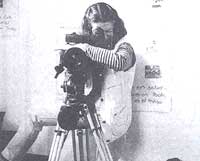Qualitywise, India is miles ahead
 THE TRUE test of a development video is whether it informs and motivates its viewers or sends them to sleep. And this is where many of the entries for the 'Women in Development' video competition, organised recently in New Delhi by the British Council, failed miserably, for this viewer was definitely not the only one dozing off in the tiny auditorium!
THE TRUE test of a development video is whether it informs and motivates its viewers or sends them to sleep. And this is where many of the entries for the 'Women in Development' video competition, organised recently in New Delhi by the British Council, failed miserably, for this viewer was definitely not the only one dozing off in the tiny auditorium!
One feels compelled to say the two Indian entries, which were among the eight final prize winners, far outclassed the other entries in production quality, pace and purposefulness. There were 78 entries from 23 countries.
The purpose of the competition was to publicise the work of women in the process of social and economic development and to promote the use of video in development. This is happening more frequently in India, which perhaps explains the excellence of the Indian videos.
Spontaneous agitation Call of the Forests, an absorbing 25-minute film made by independent producer Raman Mann, was easily the best of the bunch. It documents a spontaneous Chipko-type agitation by the Gond women of Asna village in Bastar district, which successfully persuaded the forest department to drop its plans to fence off large tracts of forest land for an afforestation programme.
Right at the outset, the film announces the original agitation, which took place in February 1987, was being re-enacted for it by the same women who had taken part in it. A sensible thing to do, because you no longer have to wonder all through whether the dramatic exchanges being shown are staged.
Call of the Forests is briskly narrated, beautifully filmed in Bastar's jungles and brought alive by the unsophisticated vigour of Mukti Bai, the leader of the agitation. It also interviews the officer who was collector of Bastar during that period. He declares candidly the government can backtrack on a policy decision if it is convinced the people have a valid point in their opposition to it. The film is produced by the National Federation of Indian Women.
A second film from India, called Malshiras: A Case Study, takes a look at how a rural project is born, how it finds direction and then, if the right decisions are taken, reaches a self-sustaining stage that allows the original catalysts to withdraw. Made by Urmila Mohite at the Educational Media Research Centre in Pune, it is a refreshing example of a good film produced by a government organisation.
Repetitive message A film made by a practising advocate in Pakistan, Mother, There Are Many Things I Desire focusses on the intense desire of a little girl in a brick kiln to go to school. If it is repetitive, it is probably because it is targeted at brick kiln workers.
Ghana has a regional appropriate technology project called GRATIS, which has produced a film on how improved technologies are benefitting artisans. Women are mastering engineering, reducing their own drudgery and making profits. It is made in a paternalistic style: mostly narrated, with the artisans saying nothing themselves. The camera-work is also pedestrian.
Zimbabwe's two prize-winning entries had obviously been chosen for their information and motivation value. Your Child Too is a message on what a women's rights are with regard to child maintenance. Fatima, A Family Investment is meant to be inspirational, and shows how a single mother of seven can raise her children successfully with grit and courage. Production-wise, both are amateurish.
The judges of the competition seem to have given the subject and the circumstances of a film's production precedence over its production qualities. This is only fair as we are talking of using video as a tool in development. The entry from Bangladesh was laudable because it was made by a village housewife, a member of Proshika, one of Bangladesh's larger voluntary organisations. Proshika has decentralised video technology to the level of the assetless rural poor so that they can make films on problems and issues concerning themselves.
